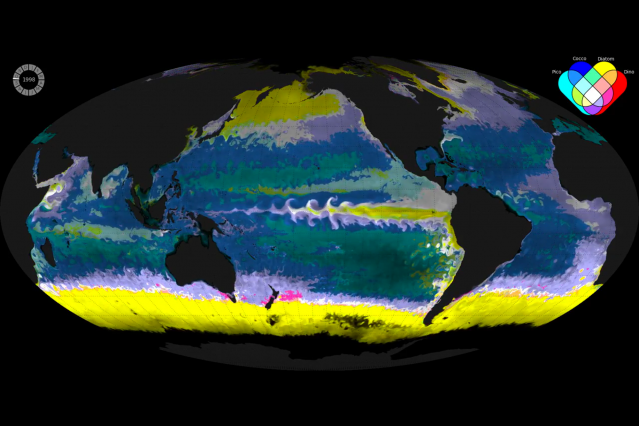Research

Understanding Biogeochemical Cycles of Carbon and Nutrients in the Ocean
Microbes sustain all of Earth’s habitats, including its largest biome, the global ocean. Microbes in the sea capture solar energy, catalyze biogeochemical transformations of important elements, produce and consume greenhouse gases, and fuel the marine food web. Measuring and modeling the distribution, composition, and function of microbial communities, and their interactions with the environment, are key to understanding these fundamental processes in the ocean.
Work in my group (the MIT Darwin Project) seeks to advance the development and application of novel models of marine microbes and microbial communities, identifying the relationships of individuals and communities to their environment, connecting cellular-scale processes to global microbial community structure.
Our research is funded through the Simons Foundation Life Science’s Program in Microbial Oceanography. With their generous support, we are involved in the Simons Collaboration on Computational Biogeochemical Modeling of Marine Ecosystems (CBIOMES) which I lead, and the Simons Collaboration on Ocean Processes and Ecology (SCOPE) and SCOPE Gradients.
CBIOMES: Models of Marine Microbial
Biogeography and Biogeochemistry
Microbial communities in the sea mediate the global cycles of elements including climatically significant carbon, sulfur, and nitrogen. Photosynthetic microbes in the surface ocean fix carbon and other elements into organic molecules, fueling food webs that sustain fisheries and most other life in the ocean. Sinking and subducted organic matter is remineralized and respired in the dark, sub-surface ocean maintaining a store of carbon about three times the size of the atmospheric inventory of CO2.
The communities of microbes that sustain these global-scale cycles are functionally and genetically extremely diverse, non-uniformly distributed and sparsely sampled. Their biogeography reflects selection according to the relative fitness of myriad combinations of traits that govern interactions with the environment and other organisms. Trait-based theory and simulations provide tools with which to interpret biogeography and microbial mediation of biogeochemical cycles.
Several outstanding challenges remain: observations to constrain the biogeography of marine microbes are still sparse and based on eclectic sampling methods, theories of the organization of the system have not been quantitatively tested, and the models used to simulate the system still lack sufficiently mechanistic biological foundations that will enable meaningful, dynamic simulations and state estimation.
In our research we seek to integrate key new data sets in real-time as they are collected at sea to facilitate direct tests of theoretical predictions; to synthesize an atlas of marine microbial biogeography suitable for testing some specific ecological theories and quantifying the skill of numerical simulations; to develop new trait-based models and simulations of regional and global microbial communities bringing to bear the power of metabolic constraints and knowledge of macro-molecular composition; to analyze these data and models using statistical tools to interpolate and extrapolate the sparse data sets, formally quantify the skill of numerical simulations, and employ data assimilation technologies to identify and optimize compatible model frameworks.
Together, we look forward to the results of these efforts advancing new theoretical approaches, and leading to improved global ocean-scale predictions and regional state-estimates, constrained by observed biogeography, while also providing a quantification of the associated biogeochemical fluxes.
SCOPE: Interpreting the Organization of Microbial Communities in the North Pacific Using Theory and Numerical Simulations
Natural microbial populations can appear bewilderingly complex, with assemblages of organisms spanning many orders of magnitude in size, diverse biochemical functionality, and extremely rich genetic variation. In any system we seek to understand which actors are present, which are absent, and why? What are the consequences for the ecosystem function and the flow of elements in that environment? Idealized theory and numerical simulations provide a means to synthesize and organize understanding of the pressures that shape microbial systems. They help frame hypotheses that can be tested in the laboratory and field.
This collaborative effort is employing data, theory and numerical simulations to test the hypothesis that the large-scale horizontal and vertical structures of the microbial communities of North Pacific Subtropical Gyre reflect a system close to equilibrium, organized by resource supply ratios. Members of my group are collaborating on new, quantitative descriptions of the costs and benefits to the individual of specific functionality, including nitrogen fixation, and of both competition and cooperation between diverse microbes. Basin-scale numerical simulations of the circulation, chemistry, and ecosystem of the North Pacific we are developing using the Darwin marine ecosystem model provide a means to illustrate and explore the large-scale consequences of these small-scale interactions.
SCOPE Gradients
The transition zones between the North Pacific Subtropical Gyre and neighboring ecosystems, notably the North Pacific Subpolar Gyre, exhibit steep changes in environmental conditions (gradients) associated with dramatic changes in the microbial ecosystem. These zones form ideal locations within which to understand the mechanisms that structure microbial communities and to test ecological theories of how resource supply ratios drive productivity, export, particle size distributions, and elemental stoichiometry. Two key aims members of my group are contributing to are (a) to develop and test theories and models to explain changes in phytoplankton populations along environmental gradients and (b) to understand and develop mechanistic models for the elemental and macromolecular composition of microbial communities across environmental gradients.
It is exciting to integrate these theory and modeling activities closely with the design, execution, and analysis of the field observations.
